Trees Birds Mammals Fish Amphibians Reptiles
Wild Algarve
Bookshop
Clitocybe gibba (Pers.) P. Kumm. - Common Funnel
Phylum: Basidiomycota - Class: Agaricomycetes - Order: Agaricales - Family: Tricholomataceae
Distribution - Taxonomic History - Etymology - Culinary Notes - Identification - Reference Sources
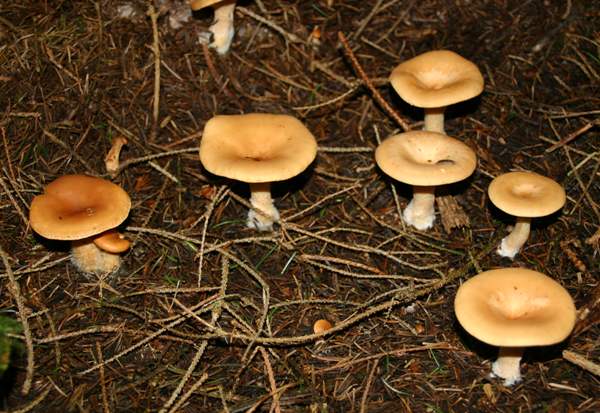
Taxonomy
Clitocybe gibba grows in
leaf litter in deciduous woodland and rough grass or heaths. The dark
cream or pale brown cap can be 10cm diameter at maturity. Like most of the fungi in this genus, it is a gregarious mushroom and often forms large arcs or even complete fairy rings.
Distribution
Very common throughout Britain and Ireland, the Common Funnel also occurs in most parts of mainland Europe and in North America.
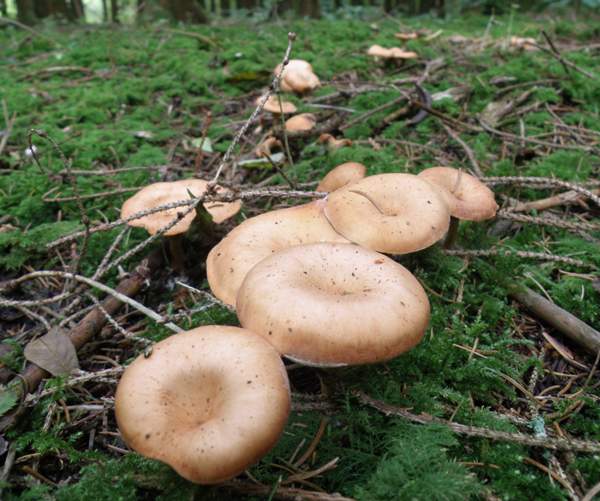
Taxonomic history
The Common Funnel was described in 1801 by Christiaan Hendrick Persoon, who named it Agaricus gibbus. Its currently accepted (although not by all authorities - see below) scientific name was established by Paul Kummer in 1871.
Synonyms of Clitocybe gibba include Agaricus gibbus Pers., Agaricus gibbus var. membranaceus Fr., Agaricus infundibuliformis Schaeff., Clitocybe infundibuliformis (Schaeff.) Fr., Clitocybe infundibuliformis var. membranacea (Fr.) Massee, and Omphalia gibba (Pers.) Gray.
Results of DNA studies in 2003 prompted mycologists to set up a new genus Infundibulicybe with Infundibulicybe geotropa (synonym Clitocybe geotropa) as the type species. Into this genus the Common Funnel and its close relatives have been transferred, and in North America in particular the Common Funnel is more commonly recognised as Infundibulicybe gibba (Pers.) Harmaja.
Common Funnels often form large arcs and sometimes complete fairy rings. The picture above, taken in mixed woodland in West Wales, UK, shows part of a fairy ring that was almost ten metres in diameter.
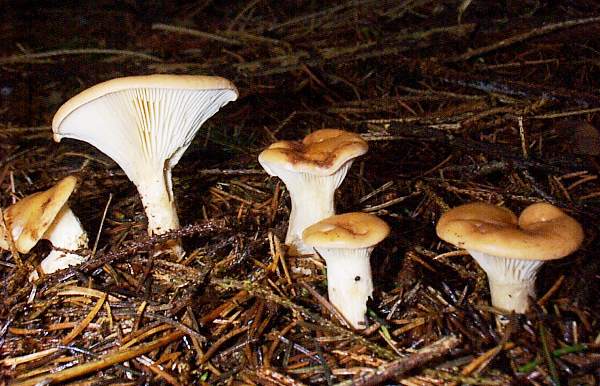
Etymology
The generic name Clitocybe means
'sloping head', while the specific epithet gibba means humped or rounded.
Identification guide
 |
Cap
4 to 8cm in diameter when fully mature,
the caps are smooth and silky, usually with a wavy edge, and creamy-brown,
sometimes with a pinkish tinge.
Initially convex, the caps expand and develop into funnels. The thick,
soft flesh is light buff. |
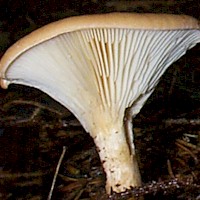 |
Gills
This funnel cap has deeply decurrent, white or
pale buff gills that are narrow and quite crowded.
Stem
5 to 10mm in diameter and 3 to 7cm tall, the buff stems are tough, often hollow, and only
slightly bulbous at the base. There is no stem ring. |
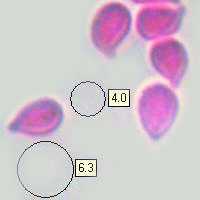 |
Spores
Ellipsoidal to pip-shaped, smooth, 5.5-8 x 3.5-5μm.
Spore print
White. |
Odour/taste |
Very faint odour of almonds (some say of
new-mown hay); no distinctive taste. |
Habitat & Ecological role |
Saprobic, in leaf litter under hedgerows, in broad-leaf
woods and on heaths. |
Season |
July to November in Britain and Ireland. |
Similar species |
Lepista flaccida, commonly known as the Tawny Funnel Cap, has
a larger red-brown cap and pale gills that become tawny with age; its spores are creamy-white, smaller and rounder than those of Clitocybe gibba, and finely warty. |
Culinary Notes
Clitocybe gibba is generally considered to be an acceptable edible mushroom, although not in the top rank. When young and fresh it can be used either fried with onions or in risottos, soups and many other mushroom dishes. The stems of Clitocybe mushrooms are rather tough and so many people discard them and eat just the caps.
Reference Sources
Fascinated by Fungi, 2nd Edition, Pat O'Reilly 2016, reprinted by Coch-y-bonddu Books in 2022.
British Mycological Society (2010). English Names for Fungi
Courtecuisse. R. & Duhem. B., Mushrooms and Toadstools of Britain & Europe (1995), p.173.
Bon, M., The Mushrooms and Toadstools of Britain and North-western Europe (1987), p.135.
Funga Nordica, Henning Knudsen and Jan Vesterholt, 2008.
Dictionary of the Fungi; Paul M. Kirk, Paul F. Cannon, David W. Minter and J. A. Stalpers; CABI, 2008
Taxonomic history and synonym information on these pages is drawn from many sources but in particular from the British Mycological Society's GB Checklist of Fungi.
Top of page...
Fascinated by Fungi. Back by popular demand, Pat O'Reilly's best-selling 450-page hardback book is available now. The latest second edition was republished with a sparkling new cover design in September 2022 by Coch-y-Bonddu Books. Full details and copies are available from the publisher's online bookshop...